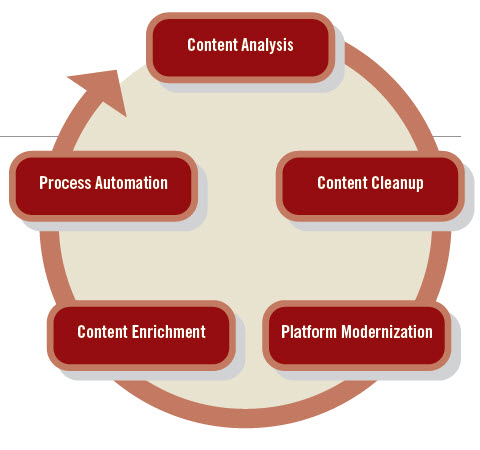A Content Journey Every Enterprise Should Be Thinking About
Addressing any of these is a daunting challenge for any organization, but it’s important to point out that the common thread among them is content. If we can understand, manage, and use our content to improve compliance, governance, and process automation, we can better address each of these forces.
All organizations, no matter their size, should be thinking about how they can clean, modernize, govern, enrich, and automate their content. Content needs to be actionable, searchable, and available to today’s workforce. But, where do you start?
Embarking on a content journey (depicted in the featured image) will address the driving forces mentioned above, allow organizations to take advantage of best-of-breed SaaS (software-as-a-service) offerings, and provide the workforce with the right tools and content when and where they want it.
Such a journey can begin at any point in the cycle (shown in the featured image), but most organizations will find that beginning with content analysis affords the best starting point.
Content Analysis: Gaining an understanding of what you have, where you have it, and what the risk is provides a valuable foundation upon which all other activities along the journey can benefit.
Content Cleanup: Eliminating risk and ROT (redundant, outdated, and trivial content) in the early stages allows organizations to mitigate the risk of unsecured sensitive data and focus on the content of value.
Platform Modernization: Moving to cloud content services and upgrading taxonomies and content architectures are examples of this. Modern approaches like these allow you to do more with, and get greater value out of, your content of value as well as automate the disposition of ROT.
Process Automation: Optimizing processes and extracting metadata to make content actionable should be priorities for any content journey. Investments like these can impact the bottom line, improve supply chains, enhance customer relationships, and more.
A content governance and automation journey is just that: a journey.
Here are a few tangible steps you can take today to get started:
Develop a content profile for your organization – A good content profile helps you understand what you have, where it exists, and who has access to it. It should look at all unstructured data across file shares, SharePoint sites, cloud storage, and other repositories. This will provide a good understanding of areas of risk (e.g., regulated, private, unsecure) as well as content that has no value.
Inventory your systems – It is critical to inventory and understand what applications are using your content, what applications are creating content, and how those systems are being accessed (e.g., internally, via mobile, via the web).
Business strategy – Consider the impact that content will have on your digital transformation and how your business could support, or hold back, your plans for efficiency and engagement.
Bring in expertise – Efforts like these can often go faster and more efficiently when outside experts are brought in. Proven methodologies, templates, and proprietary tools can all be brought to bear to help get it right the first time around.
Final word: A content governance and automation journey is just that: a journey. Proper time and commitment to planning, architecting, and providing governance controls to all your content along the way is essential. Organizations must have the mettle to properly maintain the content of value and delete content when its useful life has expired.
[/glossary_exclude]
recent posts
You may already have a formal Data Governance program in [...]

